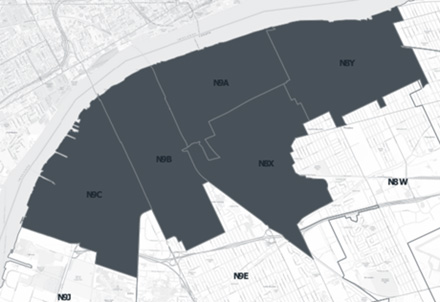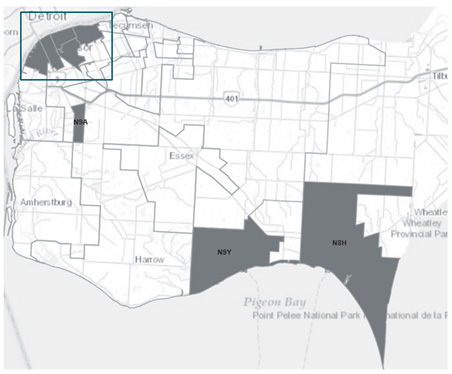To understand our planned services and budget, it is imperative to understand the needs of the community in Windsor and Essex County (WEC) including the public health challenges we face and attempt to address with finite financial and human resources. Beyond specific data driven community needs, in some instances the Ministry of Health (MOH) outlines requirements that must be fulfilled based upon the Ontario Public Health Standards (OPHS) and related legislation.
In 2016, the WECHU completed a Community Needs Assessment (CNA) to identify population health needs and to describe factors that should be addressed to improve the health and well-being of individuals in our community. The assessment was updated in 2019 to identify any new or emerging trends that were previously unidentified. The findings highlight opportunities for the WECHU and its community partners in addressing and prioritizing the health needs of our community. For more information, please see the 2019 Community Needs Assessment on the WECHU website and the Ontario Public Health Standards.
While the COVID-19 pandemic had a significant impact on the WECHU’s ability to conduct population level health assessment and surveillance, population health assessments continued to be conducted in critical areas. This included monitoring of opioid use/overdoses to inform planning and local efforts to mitigate the impact of opioids; as well as monitoring and sharing mental health-related data with local partners to plan and implement priority population-focused interventions.
The WECHU has also developed several interactive, publicly available local surveillance dashboards to provide visual and interactive data to WECHU staff, local stakeholders, policy and decision-makers, community partners, and the community to understand the health status and well-being of Windsor and Essex County residents. These include surveillance data related to local oral health, infectious diseases, immunizations, chronic diseases, child health, reproductive health, injury, substance use and mental health. These efforts, in conjunction with rapid population health assessments were used to inform program planning information related to the Annual Service Plan for 2024.
Local Priority Populations
Priority populations are a subset of the population for whom a specific program is tailored based on marginalization, vulnerability, or other risk factors. The Ontario Public Health Standards (OPHS) mandate the identification of local priority populations to deliver public health programs and services to meet the needs of the local community. Examples of local data related to priority populations include:
- The proportion of individuals living in low-income households is higher in all age groups (except those 65 years+) in WEC compared to Ontario.
- 16.5% of children (0-5 years old) and 14.5% of all children (0-17 years old) in WEC live below the low-income measure after tax (LIM-AT) compared to 12.4% and 11.5% for all of Ontario.
- 25.7% of children in WEC live in single parent households, compared to 23% in Ontario.
- In 2021-2022, 18.9% of households in WEC were food insecure, an increase from 2019-2020 when the number was 17.4%.
- Windsor-Essex has the largest population of International Agricultural workers (IAWs) in Canada. During the peak growing season, there are approximately 8,000 -10,000 employed at 176 farms in Windsor-Essex.
- 24% of the population identify themselves as a visible minority with the majority self-identifying as Arab, Black, or South Asian. Overall, immigrants make up 23% of the population and recent immigrants account for 4% of the population, with the largest proportion being from Iraq, Syria, or India.
To target priority populations in WEC – specifically those of low socioeconomic status – the WECHU has identified several high priority postal codes (N8H, N8X, N8Y, N9A, N9B, N9C, and N9Y). In Windsor this includes all of Wards 2, 3, and 4 as well as portions of Wards 10 and 5. In Essex County, this includes portions of Leamington and Kingsville. The postal codes are mapped below:


Unique Local Challenges and Risks
As a function of planned services and budgetary considerations the BOH (under the OPHS and related legislation) is required to identify unique local challenges, issues, and/or risks being faced by our community which influence the work of the BOH, including details on any health issues where local rates are higher than the provincial rate. Local examples used to inform planned services and budgetary considerations include:
- At least 27.6% of WEC residents are not enrolled with a Primary Care Physician who participates in an Ontario Primary Care Model (PEM), compared to 26% in Ontario. The number is higher in WEC priority postal code neighbourhoods, where at least 32.6% of residents are not enrolled.
- The health equity gap for Mental Health ER visits in WEC is significantly worse than Ontario with the most marginalized residents being 3.5 times more likely to visit the ER for mental health concerns than the least marginalized (compared to a 2:1 ratio for Ontario) (PHO, 2017).
- WEC has seen a worsening trend of oral health related indicators for children in the community. In 2022/2023, data showed that 14% of children screened in schools required urgent dental care, compared to 12.4% in 2018/2019.
- Between 2022 and 2023, cases of HIV and Syphilis have increased substantially. In 2022 and 2023, there were 4 cases of congenital syphilis, the first cases since at least 2013.
- The health equity gap for Oral Health ER visits in WEC is significantly worse than Ontario. In 2017, the most marginalized were 4.5 times more likely to visit the ER for oral health concerns than the least marginalized (compared to a 3:1 ratio for Ontario).
- In 2021, the rate of alcohol-related hospitalizations was higher amongst WEC residents compared to the rest of the province.
- Demand for the Ontario Seniors Dental Care Program continues to be very high, with a waitlist of approximately six months.
- The WECHU has approximately 1200 seasonal housing accommodations as of October 2023 that require inspections every 8 months, as required by the Government of Canda (Service Canada).
- In 2022 WEC the proportion of infants exclusively breastfed at discharge from hospital was 45.7% (compared to 52.8% in Ontario).
- WEC has 468 high-risk food premises (e.g., food services in long-term care/retirement homes and childcare settings).
- In 2022, Windsor-Essex recorded the highest number of opioid deaths in any year since at least 2013. The rate of opioid related deaths in WEC has been higher compared to Ontario in all years since at least 2005 apart from 2014 and 2017.
- WEC has established the presence of vector-borne diseases (VBD). Through an enhanced VBD surveillance program, WECHU identified:
- 12 mosquito pools tested positive for West Nile Virus in 2022 with 3 human WNV cases.
- 822 adult Ae. albopictus mosquitoes, vectors of Zika virus.
- 12 mosquito pools tested positive for West Nile Virus in 2022 with 3 human WNV cases.

